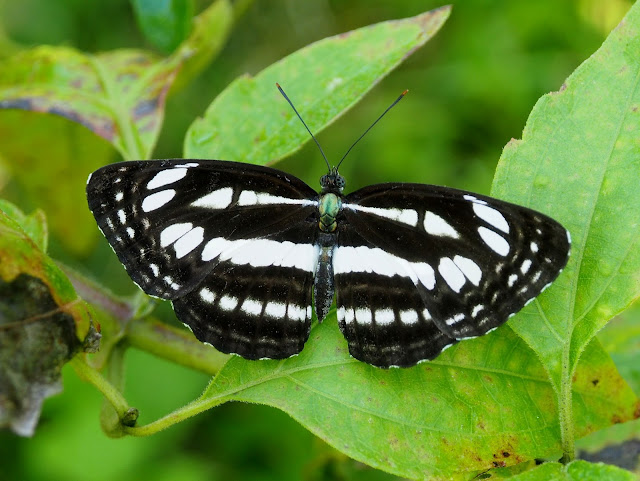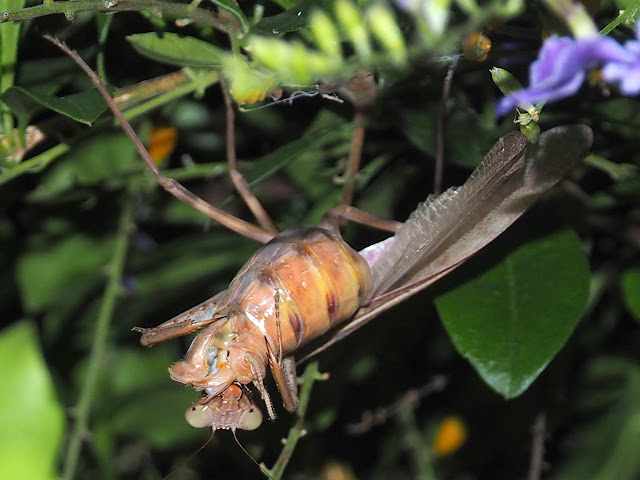Our area in the province is a bit hot for butterfly photography. And these butterflies do not appear in our garden in the early morning when they are just basking to dry their wings. I tried going out in the field to find them, but only a few are out early morning. I guess they are still hiding in non-accessible areas and just go out when they are ready to nectar or to find their mates. That time they are already very flighty, which fatigued my camera to the fullest. Can you imagine now the rate my drives get filled up? I told you so, i am a hoarder too, of bad photos.
What follows are just some of the few decent shots i culled from them, cropped mainly. They are all taken on Sept 3-4, 2017.
DARK BLUE TIGER, Tirumala hamata orientalis Semper 1879
Nymphalidae; Danainae; Danaini
COMMON SNOW FLAT, Tagiades japetus titus
Hesperiidae, Pyrginae, Tagiadin
DWARF CROW OR SMALL BROWN CROW, Euploea tulliolus pollita Erihson 1834 Nymphalidae; Danainae; Euploeini
GREY GLASSY TIGER, Euploea tulliolus pollita Erihson 1834
Nymphalidae; Danainae; Danaini
COMMON LIME, Papilio demoleus demoleus
(Butterfly With Disability, BWD)
COMMON MORMON, Menelaides polytes ledebouria (male)
Papilionidae, Papilioninae, Papilionini
COMMON MORMON, Menelaides polytes ledebouria (female)
Papilionidae, Papilioninae, Papilionini
SAILER, Lasippa illigera illigera Escholtz 1821
Nymphalidae; Nymphalinae; Limenitidini
TYPICAL SAILER, Neptis mindorana ilocana C. & R. Felder 1863
Nymphalidae; Nymphalinae; Limenitidini
TYPICAL SAILER, Neptis mindorana ilocana C. & R. Felder 1863
Nymphalidae; Nymphalinae; Limenitidini
THREE-SPOT GRASS YELLOW, Eurema blanda visellia Fruhstorfer 1910
Pieridae; Coliadinae
BUSHBROWN, Mycalesis igoleta igoleta C. & R. Felder 1863
Nymphalidae; Satyrinae
SCARLET MORMON, Menelaides deiphobus rumanzovia Eschscholtz 1821
Papilionidae; Papilioninae; Papilionini
GREAT EGGFLY, Hypolimnas bolina philippensis ♀ Butler 1874
Nymphalidae; Nymphalinae; Nymphaliini
GREAT EGGFLY, Hypolimnas bolina philippensis ♂ Butler 1874
Nymphalidae; Nymphalinae; Nymphaliini
LEMON EMIGRANT, Catopsila pomona pomona ♂ form hilaria Fabricius 1775
Pieridae; Coliadinae
What follows are some of the better photos from the plenty of shots i am telling you about. These are cropped, but most of those left in my drives are not croppable. An instance is that after properly focusing, it suddenly leaps when you press the shutter. You are then left with a blurred photo or a twisted butterfly which does not sometimes resemble one! They are a bit funny, yet i really cannot fully delete them.
a crow, a common mormon and a lemon emigrant
a common mormon which almost reaches the ceiling when flying
an eggfly, a common mormon and a blurred skipper at the middle
both common mormons
Because it is too far, you cannot even see where the butterfly is, yet it will not be nice when cropped! So do you suggest that i delete all of the last 3 photos?























































